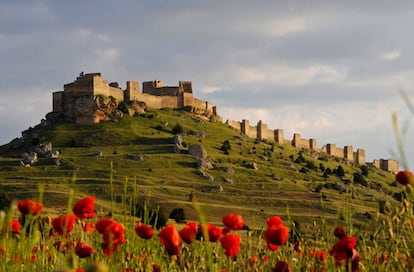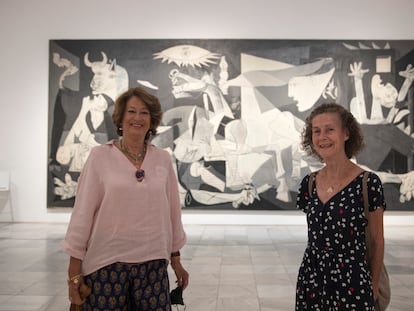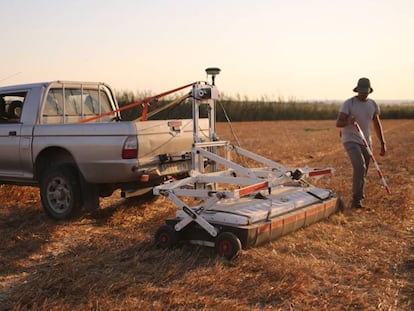The macro pig farm threatening a historical gem in northern Spain
City councils, environmentalists, architects, museums and locals are up in arms against plans for a business involving 4,200 animals, which they say will be an eyesore from Gormaz castle in Soria


Christians and Muslims fought over the castle of Gormaz in Soria in the Spanish region of Castilla y León for two centuries. Now, after a lapse of hundreds of years, it is once again under threat – this time, from a macro pig farm for 4,200 animals. The proposed farm is within two kilometers of the fortress, and will be visible from its impressive caliphal gate, which is one of the biggest tourist attractions of the medieval site.
Environmental and neighborhood associations, architecture and restoration professionals, as well as the town councils of Recuerda, a village of 70 inhabitants, and Gormaz, a village of 20, call the plans an “attack” on one of the most impressive Islamic fortresses on the peninsula. With a perimeter measuring more than one kilometer, the castle of Gormaz was once the largest in Europe. It was this fortress that the Caliph of Córdoba, Al-Hakam II, ordered to be reinforced and expanded at the end of the 10th century to stop the Christian advance from the north.
Meanwhile, the company behind the project, Agro Peñaranda Esteban, insists it will comply “strictly with the law” and that if the permits are not issued, it will go elsewhere. “It’s great to eat torreznos [a kind of fried bacon snack] from Soria in a good restaurant in a big capital city,” says one of the shareholders, who is from the area. “People must think that they fall from the sky.”
The castle of Gormaz was built in the 9th century to strategically support Medinaceli, the capital of the so-called Muslim Middle Frontier. Divided into two large areas separated by a moat, there is the fortress with the tower of Almanzor and the caliphal quarters, and then the area for the troops, where the main entrance is located. Altogether, it has 28 towers with battlements and arrowslits.
The Soria fortress defended the routes to the north of the peninsula that followed the banks of the Duero river and was coveted by a number of figures, including Count García Fernández, Sancho II of Pamplona, Ramiro III of León, Rodrigo Díaz de Vivar and the de facto ruler of Islamic Iberia, Almanzor. And so it passed from one side to the other until, in 1060, Fernando I of León seized it once and for all. During the reign of Spain’s Catholic Monarchs, it was turned into a prison as it no longer had any strategic value.
But now it is administrative forces that are advancing on the castle. On June 29, the Castilla y León regional government published “the announcement of a pig farm of 4,200 pigs in plot 20114 of industrial estate 1 of the municipality of Recuerda,” which backs onto Gormaz. August 10 was the deadline for anyone wishing to take issue with the environmental impact assessment, which states that the farm would not alter the surrounding landscape. “It is a landscape altered by human activity, due to its agricultural use, with no dominant variations or striking contrasts,” claims the report.
This contradicts the regional plan for the Duero Valley, approved by the Castilla y León regional authorities in 2010, which mentions a series of Landscape Management Areas (AOP) needing a specific regime of protection, management and planning. One such area includes the castle of Gormaz and the surrounding area where the farm would be located.
Luis Morales, architect and member of the Soria Association for the Defense of Nature (Aseden), points out that the castle’s environment is “totally agricultural – fields and forests – and very similar to what it might have been in the Middle Ages, when Gormaz was built. To put an industrial complex of enormous dimensions to house more than 4,000 pigs, which is what they intend, is barbaric,” he adds. “It breaks up the landscape from the same caliphal gate, the one that is so often photographed for tourism purposes.”
Morales also believes that the municipalities have the means to stop the project, “because the land is rustic and can therefore be classified as protected, which would prevent the livestock complex from being built.” Meanwhile, the Aseden association points out that the regional authorities were responsible for the White Paper of the Territorial Enclaves of Cultural Interest (ETIC), which selected 111 locations of cultural or heritage interest, one of which was Gormaz.
According to the NGO Ecologists in Action, in this type of facility whose surface area would be 4,000 square meters plus another 2,000 for slurry, “the problem of odor emissions is very important because of its proximity and orientation with respect to inhabited areas and other places of interest.” It explains: “In this case, the farm would be to the west, 1.3 kilometers from Recuerda and two kilometers from the castle of Gormaz. According to data from [Spain’s national weather agency] Aemet, the prevailing winds are from the west. In other words, it would bring unhealthy smells for most of the year to Recuerda. Surprisingly, the project says that the prevailing winds are from the northeast.”
Consuelo Barrio, mayor of Recuerda, agrees. “It is not only the visual impact, which is very important, but also the environmental impact due to the possible contamination of the water from the slurry as we are in an area of aquifers; this is in addition to the smell that would come our way as we are barely a kilometer from it.”
Meanwhile, the company behind the project considers it is under “unjustified attack.” According to one 38-year-old businessman involved in the project, “in this part of Soria there are at least three farms: Quintanar, Gormaz.... And if ours smells, it means they all smell. It’s not like years ago, when pigs were thrown into the Duero – some of which I have seen floating – or the slurry was dumped down drains. No. There are strict environmental laws and we will comply with them. It is easy to talk about ‘deserted’ Spain and all the things the politicians are saying, but when you try to create wealth, obstacles are thrown up because you can be seen from the castle two kilometers away. If they don’t let us set up here, we’ll go somewhere else,” he adds angrily.
Marisa Revilla, president of Amigos del Museo Numantino, is particularly upset by the visual effect of the pig farm. “The impact report does not take into account the horizontal impact. It only states that they are going to put up some hedges to hide the farm. But the installation will not only affect the castle, it will also affect the nearby Romanesque San Miguel hermitage.” This hermitage was inspected in the 1990s by architect José Francisco Yusta, who specializes in historical monuments and also opposes the construction of the farm. “There is no justification for breaking up the landscape,” says Yusta, who has worked on such architectural gems as the cathedral of Burgo de Osma, the cathedral of Santiago de Compostela and castle of Gormaz itself.
“I believe it is not worth destroying our landscape for the two jobs that the macro-farm will provide, which are those proposed by the promoters,” says architect Luis Morales. “If there were only 200 for deserted Spain….”
English version by Heather Galloway.
Tu suscripción se está usando en otro dispositivo
¿Quieres añadir otro usuario a tu suscripción?
Si continúas leyendo en este dispositivo, no se podrá leer en el otro.
FlechaTu suscripción se está usando en otro dispositivo y solo puedes acceder a EL PAÍS desde un dispositivo a la vez.
Si quieres compartir tu cuenta, cambia tu suscripción a la modalidad Premium, así podrás añadir otro usuario. Cada uno accederá con su propia cuenta de email, lo que os permitirá personalizar vuestra experiencia en EL PAÍS.
¿Tienes una suscripción de empresa? Accede aquí para contratar más cuentas.
En el caso de no saber quién está usando tu cuenta, te recomendamos cambiar tu contraseña aquí.
Si decides continuar compartiendo tu cuenta, este mensaje se mostrará en tu dispositivo y en el de la otra persona que está usando tu cuenta de forma indefinida, afectando a tu experiencia de lectura. Puedes consultar aquí los términos y condiciones de la suscripción digital.
More information
Últimas noticias
Most viewed
- Reinhard Genzel, Nobel laureate in physics: ‘One-minute videos will never give you the truth’
- Oona Chaplin: ‘I told James Cameron that I was living in a treehouse and starting a permaculture project with a friend’
- Pablo Escobar’s hippos: A serious environmental problem, 40 years on
- Why we lost the habit of sleeping in two segments and how that changed our sense of time
- Charles Dubouloz, mountaineering star, retires at 36 with a farewell tour inspired by Walter Bonatti










































